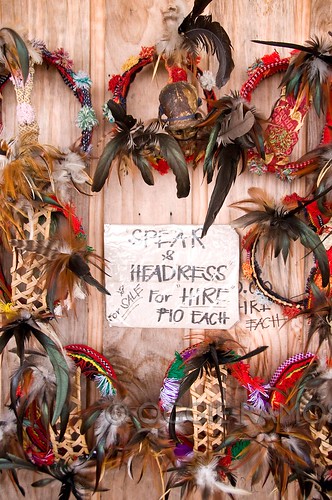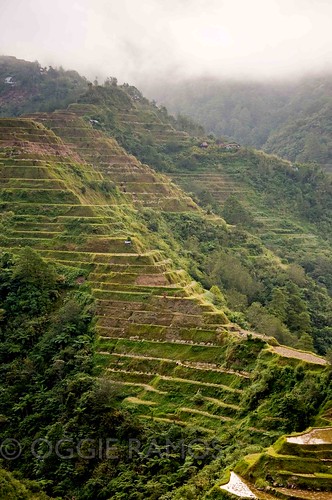You've seen one set of rice terraces, you've seen them all, right? Not quite. When you come face to face with what we Pinoys fondly call "the eighth wonder of the world", it's not easy to be blase. The terraces, especially the ones in Banaue, are simply breathtaking to behold. One can't help but begin to fathom the ingenuity, creativity and painstaking amount of labor that went into carving the mountains to be able to plant rice in such challenging topography.
The China link. The American anthropologist, H. Otley Beyer, wrote that the Ifugaos and their other mountain-terracing brothers are linked to migrants from Tonkin in Southern China, bringing with them their knowledge of copper and rice. This may explain why there are also rice terraces in some areas in China in elsewhere in Southeast Asia like the highlands of Northern Vietnam. But nowhere in the world can such extensive mountain terracing be found except here. In her book, Two for the Road, travel writer Annie Feleo wrote that put end to end, the terraces would encircle half the globe.
The China link. The American anthropologist, H. Otley Beyer, wrote that the Ifugaos and their other mountain-terracing brothers are linked to migrants from Tonkin in Southern China, bringing with them their knowledge of copper and rice. This may explain why there are also rice terraces in some areas in China in elsewhere in Southeast Asia like the highlands of Northern Vietnam. But nowhere in the world can such extensive mountain terracing be found except here. In her book, Two for the Road, travel writer Annie Feleo wrote that put end to end, the terraces would encircle half the globe.
 Engineering marvels. The construction of the terraces also differ from place to place. Looking more closely, the ones in Banaue are walled in by hard soil while the ones in Bontoc are held in place with river rocks (how those rocks got there is already a marvel). Annie wrote that the locals first reinforced the entire base with either soil or rocks, with the walls extending at least two meters below ground level. She added that it is believed that that aggregate weight of the stones used surpasses the weight of the stones used to build the pyramids of Egypt. Mind-boggling feat indeed.
Engineering marvels. The construction of the terraces also differ from place to place. Looking more closely, the ones in Banaue are walled in by hard soil while the ones in Bontoc are held in place with river rocks (how those rocks got there is already a marvel). Annie wrote that the locals first reinforced the entire base with either soil or rocks, with the walls extending at least two meters below ground level. She added that it is believed that that aggregate weight of the stones used surpasses the weight of the stones used to build the pyramids of Egypt. Mind-boggling feat indeed.At one viewpoint, we thought the terraces were so steeply-angled (almost pyramid-like) that we were looking at something that came out of Peru's Machu Picchu. One more thing, the rice terraces in the Cordilleras are not just plain rice terraces per se but are also planted with vegetables (such as the ones in Atok), tubers (Bontoc) or in between harvest and planting seasons, turned into fishponds.
We came back to Banaue for another day and night of going around. We would've wanted to billet ourselves in Banaue View which sits on top of a hill overlooking the poblacion but it was a steep descent and some distance away from the eateries (and pardon my hurting knees, they really need some rest). So we settled for Stairway Lodge which is on the busy main street right beside an internet cafe (!). After a nap and a belated lunch, we hired two tricycles going to the different designated viewpoints around Banaue. We started out with a fairly blue sky overhead but by the time we got to the main viewpoint, heavy fog was obscuring the terraces and the wind was chilling us to the bone. Even the locals who'd pose for tourists were huddled inside one of the souvenir shops, hidden from the relentless wind. Still, the terraces are a sight to behold and the moody sky only painted them with a mysterious pall. We left when light rain began falling, hoping to see the terraces again one day soon.
Info: Tricycles can be hired to tour the viewpoints at P100/pax; the steep road means only two persons can be accommodated per tricycle. The main viewpoint is a 20-minute ride from the town center. There are souvenir shops there as well as Ifugao locals in their colorful garb who will be willing to have their pictures taken for a small donation. • Stairway Lodge is around 50 meters away from the Banaue Tourism Council's office; rooms range from double to four bed units with hot shower; fees from P300-400/pax; contact 0906.6834996, 0926.3221040 or 0926.8082801. • Attribution:Two for the Road, Travel Tales by Anita Feleo and David Sheniak, 1998, Anvil Publishing • Go on a photographic tour of Banaue with Backpack Photography 101: Banaue. For details, visit www.ferdzdecena.com/workshops or call/text 0906.4534133.



